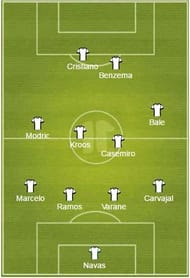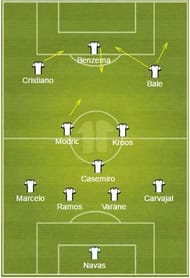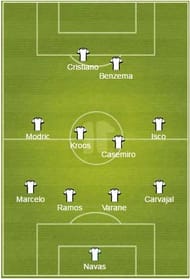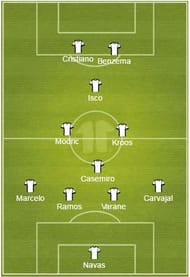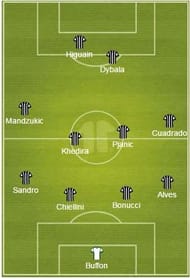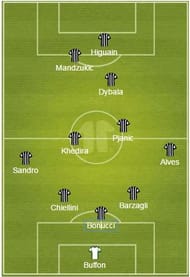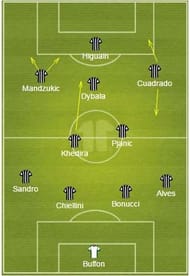It has been a long time since two teams so tactically fluid faced each other in the final of the Champions League. At a time where most people are fixated about formations and the role of each player in his designated area, both Zinedine Zidane and Max Allegri have carved out a system that can’t really be confined to any certain formation.
Real Madrid
For the papers, the Blancos line-up in a 4-3-3 formation when Gareth Bale plays. However, without the presence of the Welshman, Zinedine mostly starts with a 4-3-1-2 with Isco behind the strikers, Cristiano Ronaldo and Karim Benzema or Alvaro Morata.
The 4-3-3: Defensive shape
Like most teams in Europe, the Galacticos, when not in possession of the ball, defend with two banks of 4 players which can be dubbed as the classic 4-4-2. The midfield quartet consists of Casemiro and Toni Kroos in the middle, Luka Modric on the left and Gareth Bale on the right.
One of the major reasons for Gareth Bale’s poor form this season is the fact that he has been burdened with a lot more defensive duties than last season. The moment Madrid get the ball, Gareth Bale finds himself deep on the right-wing with a lot of ground to cover.
But Zinedine Zidane has no other alternative. Karim Benzema and Cristiano Ronaldo are the double pivot in attack and burdening them with defensive duties will dent Madrid’s scoring chances, which leaves Gareth Bale as the only viable option.
It is not feasible to play three players without any defensive duties. While it might work against weak sides, it always leaves the Galacticos vulnerable against the more formidable opponents. With two banks of four players defending while unpossessed, Madrid’s system compensates for providing absolute creative freedom to two players.
However, given the narrowness of the 4-4-2 due to the tendency of Toni Kroos/Luka Modric passively shifting towards the centre, Madrid are always exposed on the wings, claimed backed by the fact that the Blancos concede 16 crosses-per-game.
This also puts the full-backs in a difficult position as they often find themselves being dragged inwards by the wingers, leaving open space for the opposition full-backs to run into. But the system also has its advantages.
For one, having two banks of four allows the system to absorb pressure from the opposition players. It also makes it very hard to break Madrid through the centre due to its narrowness. In this shape, the space over the pitch is also covered properly.
The Blancos make 20.5 tackles in every game while maintaining an average possession of 54.8%, which is only bettered by RB Leipzig among the top three teams from the top four leagues in Europe with an average possession of 50% or more.
While this might not reveal much on the hindsight, it does go give the faintest of ideas that the Blancos’ players are always close enough to the opponents to make a tackle and win the ball.
The 4-3-3: Attacking shape
Once in possession, the Galacticos rush to their usual 4-3-3 as Gareth Bale speeds off towards the inside to join Karim Benzema, who drops down a little to act as the supporting pivot to Cristiano Ronaldo.
Further behind, Luka Modric floats forward to connect the midfield to the attack with Toni Kroos just behind him and Casemiro guarding the defence. The problem with this shape is that it relies a lot on the individual brilliance of the players to make the difference.
Almost often, the Blancos have been criticised by their own fans for lacking cohesion—and, as a result, identity—due to the fact that the distance between the midfield and attack in this shape was always too much, to begin with.
While Luka Modric is perhaps the best midfielder in the world, he is not a number 10 and neither is Toni Kroos. With the BBC far ahead of the midfield and almost often inside the box, Modric always finds himself with a lot of ground to cover in order to link the midfield to attack in a 4-3-3.
And this was difficult for the Croat as it resulted in the loss of form for Modric during the middle part of the season. What’s worse, it made Madrid look like a highly unstructured team.
The 4-3-1-2
Defensive Shape
With Gareth Bale out and Isco’s stunning form, Zidane had to come up with a system that brought the best out of his in-form Spanish star. For this, playing the former Malaga man in the middle was an absolute must given that all of his best games in the White shirt came when was operating from the centre.
And so came the 4-3-1-2, or a narrow 4-4-2 diamond, with Isco in the hole behind the strikers. The defensive shape in this system is similar to the one in 4-3-3 as Isco drops to the right wing and Modric or Kroos on the left to make it a conventional 4-4-2.
With Isco, however, the defensive shape works slightly better as the former Valencia starlet is more defensively tenacious than his Welsh counterpart. Indeed, with Isco in the starting XI, Real Madrid have conceded only 26 times in 24 games, which is four goals less than with Gareth Bale in the starting line up in the same number of games.
Attacking Shape
Whilst in attack they quickly morph into a 4-3-1-2 and this is where Madrid look so much more cohesive due to the presence of the number 22. What lacks in a 4-3-3—someone to link the midfield to attack—is no longer a problem in a 4-3-1-2 as Isco beautifully connects the dots to make his team look like a better unit.
This also allows Luka Modric to play more freely and with less burden since he is not alone in linking the midfield to the attack. One of the prime reasons why the Croat found his form after the slump was because of Isco’s support at connecting the midfield to the attack.
Isco’s graceful demeanour holds the Madrid stars together on the pitch and if the Blancos have looked any close to getting an identity, it is with the Spaniard on the pitch. However, the biggest problem with this system is the lack of width and the added burden on the full-backs.
Both Marcelo and Carvajal not only have to provide the width, but also become susceptible to leaving too much space behind and, as a result, allowing the opponents to run into.
Juventus
Defensive Shape
Juventus, primarily, play two formations: either their conventional 3-5-2 or their newly-implemented 4-2-3-1. Regardless of the formation Max Allegri plays the defensive shape always leans towards a narrow 4-4-2, much like Real Madrid’s.
The double pivot of Juventus consists of Miralem Pjanic and Sami Khedira. While this pair has done a good job to replace the famous trio of Arturo Vidal, Andrea Pirlo and Paul Pogba, they lack the defensive steel of their predecessors.
Hence, Allegri had to come up with a solution to play them both in front of the defence while also making sure that the lack of defensive bite isn’t exposed. In both the formations, the players generally align in a 4-4-2 when not in possession of the ball, helping out the midfield double-pivot.
The most important player for Juventus, in a purely tactical sense, is Mario Mandzukic. The Croat is the Old Lady’s first line of defence when they lose the ball. His insane pressing and relentless off-the-ball movement at the top buys Juventus time to take the defensive shape before the opponents find a gap during the transition and hit them on the counter.
Juventus’ defence gets a lot of praise for their outstanding unity, but the truth is that for any club to be a great defensive outfit, the defending needs to start from the top itself—and that is precisely what Mandzukic does.
The 3-5-2/3-4-3
The formation with which they conquered Italy, Juventus’ 3-5-2/3-4-3 has left a lasting presence on the football fraternity, so much that numerous clubs—including even Real Madrid—tried to emulate it.
However, playing a formation like this requires personnel of, in Liam’s Neeson’s voice, very particular set of skills. It is of little wonder that Juventus—the main protagonists of the modern three-man backline—also began to struggle in this formation after the departures of Andrea Pirlo and Paul Pogba.
The usual set up is this: the BBC in the 3-man backline flanked by Dani Alves and Alex Sandro on the wings, Sami Khedira and Miralem Pjanic in the centre, and the trio of Paulo Dybala, Mario Mandzukic and Gonzalo Higuain in attack.
The importance of Pjanic can’t be overstated either as the Bosnian midfielder’s innate sense of passing unlocks a great many defences. The abilities of Mandzukic to hold up play and act as the auxiliary forward is an essential part for this system to work as well.
However, the game-changers in this setup are the full-backs as they play a fundamental role in creating attacks and linking the midfield to the attack. Dani Alves, especially, has been irreplaceably important for the Old Lady when it comes to building attacks.
The 4-2-3-1
Juventus and the 3-5-2 is a love story better than the Twilight series (well, then again, what isn’t). The Old Lady have conquered Italy with that formation for the last five years, but the cracks became highly visible at the beginning of this season.
After playing the system for so many years, teams were starting to figure out the weaknesses in it—especially with the absence of Paul Pogba and Andrea Pirlo. Hence, Allegri had to come up with something, and so he did.
Allegri’s 4-2-3-1 is much like Jose Mourinho’s system with Inter Milan, however with lesser bite. While Inter had some really good physically strong midfielders, allowing them to stand off until the opponent reached their half, Juve rely heavily on pressing up front.
In this setup, the backline usually consists of Leonardo Bonucci and Giorgio Chiellini in the centre of the defence with Dani Alves and Alex Sandro on the flanks. Sami Khedira and Miralem Pjanic make the duo in the double pivot while Juan Cuadrado and Mario Mandzukic flank Paulo Dybala in the hole behind Gonzalo Higuain.
Both Juan Cuadrado and Mario Mandzukic act like the workhorses in attack, constantly harrying and bullying the opposition backline and midfield to not allow them any breathing space or time on the ball while also defensively assisting the double pivot in the process.
Juventus carry their attacks heavily through the overlapping runs of Dani Alves and Alex Sandro. It is almost as if Real Madrid and Juventus are clones of each other in this regard as the full-backs work like playmakers from the deep flanks.
Paulo Dybala, though, has the license to express himself with freedom, something that has brought the best out of him.
The tactical clash of the titans
It will be interesting to see how these two teams line up against each other. While Juventus used a three-man defence to soak up the pressure of Monaco’s youthful attack, it is highly likely that they might revert to a 4-2-3-1 against Real Madrid.
Meanwhile, with the fitness of Gareth Bale in question, it seems as though Zinedine Zidane will start Isco instead of the Welshman, meaning that the Whites could line up in a narrow 4-3-1-2.
However, for the sake of covering all angles, all the possible system clashes will be considered, beginning with the least likely:clashes will be considered, beginning with the least likely: 3-5-2 vs 4-3-3.
If Zidane decides to pull up a surprise and play Gareth Bale in his home city and if Allegri chooses to not change anything from the semi-finals, we will witness something of a tactical repeat from 2015. That year, the Old Lady managed to pip the Blancos out of the competition in the semi-final, but it would be lot harder to get the better of them this year with the conventional 3-4-3/3-5-2.
The reason for this is more due to the absence of Juventus’ midfield bite than anything else. Can the duo of Sami Khedira and Miralem Pjanic absorb the brilliance of Madrid’s midfield like the trio of Claudio Marchisio, Arturo Vidal/Paul Pogba and Andrea Pirlo did?
Also, while the presence of Alex Sandro and Dani Alves does make Juventus an attacking force to be reckoned with, it also makes them a lot more vulnerable since the Brazilian duo will almost certainly attack from the word “go”, leaving space behind them for Cristiano Ronaldo and Gareth Bale to exploit—something that didn’t happen with Stephan Lichsteiner and Patrice Evra in 2015.
The Casemiro factor will also play a crucial role here regardless of the system Madrid plays. Writing in this context only, the Blancos didn’t have a natural destroyer in their lineup the last time these two faced each other.
Indeed, then Real Madrid manager, Carlo Ancelotti, had to use Sergio Ramos in midfield in an attempt to contain the Bianconeri’s counter attacks. With Casemiro in the team this time around, the Merengues are better equipped at stopping Juventus’ lethal counters.
The next possible combination is more likely to happen than the aforementioned one: 4-3-3 vs 4-2-3-1. If this happens, then the game will be tipped in Juventus’ favour since their defensive shape and systematic discipline will frustrate Los Blancos despite having an extra man in deep midfield.
And then there is the clash between Juventus’ 3-5-2 and Madrid’s 4-3-1-2. If this is how the teams pan out, the game will be won by the team that makes better use of the flanks, where Madrid could have an advantage due to the 2 on 1 situations that will arise.
However, what seems most likely is a heavily congested and midfield-centric war between two of Europe’s finest as all things point towards a 4-2-3-1 vs 4-3-1-2. In a clash of these two formations, Juventus will have the benefit of having more players on the wings to take on Madrid’s full-backs.
Madrid, meanwhile, will play a system that makes them more cohesive in attack and well-balanced in defense, but if history has shown us anything, it is that Juventus can deal with pressure from the centre all day long without breaking down—just ask Barcelona.
Isco might be a man in form, but not even the greatest midfielder in the world can pick out a pass if the forwards are marked tightly and the channels in front of him are blocked. However, Isco has something most midfielders don’t: insane close control.
The Malagan has the tendency to take matters into his own hands if he fails to find an opening for the pass—and that is the thing that could surprise the Bianconeri.
On the other end, Paulo Dybala is enjoying his best time as a footballer, but Madrid’s 3-man midfield will be difficult to overcome. However, Real Madrid a left with one gargantuan problem: Dani Alves.
Let’s face facts: Cristiano Ronaldo will not track back and in a 4-3-1-2, it is perhaps not necessary either. This leaves Luka Modric as Marcelo’s only support against Juan Cuadrado and Dani Alves. The Brazilian right-back is still enjoying his good years and can cause some serious damage if even the tiniest amount of space or time is given to him.
The tendency of both Luka Modric and Toni Kroos to push towards the centre even when the opposition has the possession will provide the former Barcelona full-back with a lot of opportunities to stamp his authority on the game—and that could be the game-deciding factor.
On the Blancos’ end, both Marcelo and Carvajal are in stunning form, but in a 4-3-1-2, the job of creating width for their team lies on their shoulders. Hence, it would be interesting to see how Real Madrid's renowned full-backs would do in a 1 v 2 situation like this.
Some say that once the players are on the pitch, all the tactics of the chalkboard go out of the window. However, in Cardiff, it will all be about tactics and the team that adheres to its tactical orders the most will most likely end up lifting the trophy.
Also read: European Team of the Year for 2016/17: Do Ronaldo and Messi make the cut?

